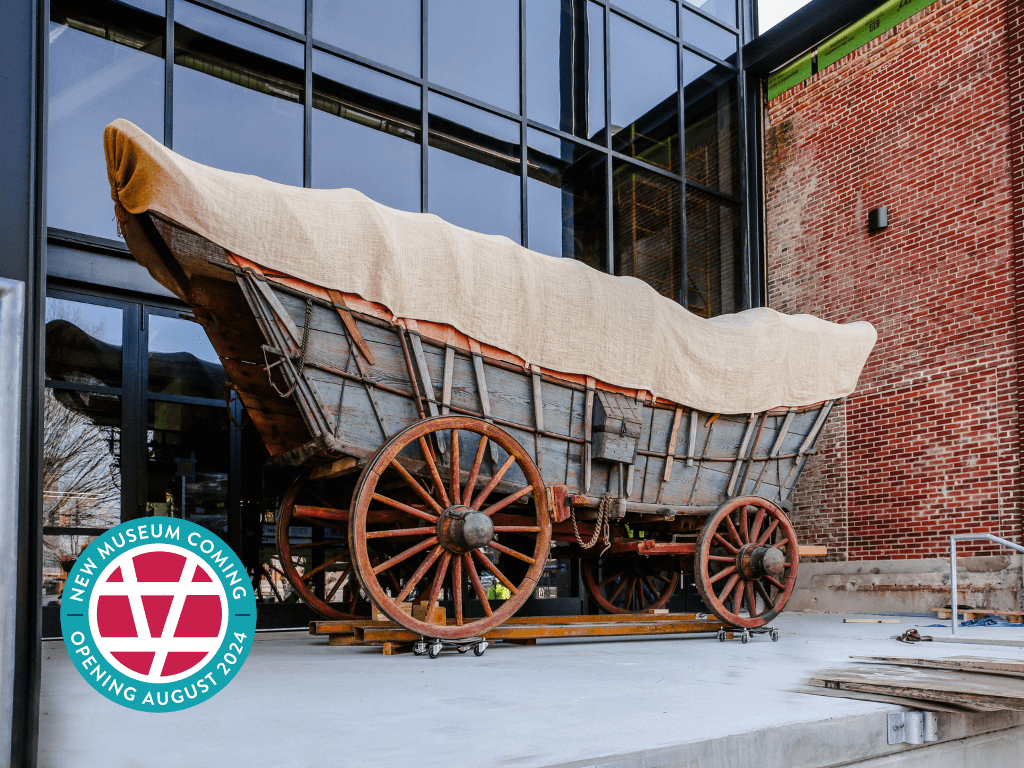Artifact Spotlight: The Conestoga Wagon



Attention, history enthusiasts. Let’s dive into the fascinating world of transportation, where everything from social gatherings to business deals and moving goods hinges on the wheels of progress. Forget the usual cars, buses, and trucks for a moment, because we’re about to take a delightful trip into early American history. And guess what? The unsung hero of our nation’s early expansion through Pennsylvania toward the Mississippi River is none other than the Conestoga wagon! Get ready for a rollicking ride through time as we explore the Conestoga’s pivotal role. And that includes our own Conestoga Wagon, which will shine in the spotlight at our brand-new History Center museum opening this summer. Get comfy, because the Conestoga has a captivating story waiting just for you!
 In 1958, the York History Center proudly acquired a Conestoga Wagon from York businessman and philanthropist Mahlon Haines. Though the exact construction date is unknown, it likely dates to the early 19th century. Originally built for the Greist family of York Springs, Adams County, the History Center’s wagon likely hauled freight from Philadelphia to Pittsburgh and is believed to have occasionally ventured even further west, although the documentation on that is not clear. Additionally, it played a significant role in transporting barrels of liquor from Baltimore, further highlighting its versatile and indispensable role in early American commerce.
In 1958, the York History Center proudly acquired a Conestoga Wagon from York businessman and philanthropist Mahlon Haines. Though the exact construction date is unknown, it likely dates to the early 19th century. Originally built for the Greist family of York Springs, Adams County, the History Center’s wagon likely hauled freight from Philadelphia to Pittsburgh and is believed to have occasionally ventured even further west, although the documentation on that is not clear. Additionally, it played a significant role in transporting barrels of liquor from Baltimore, further highlighting its versatile and indispensable role in early American commerce.
As the largest known Conestoga Wagon still in existence, it stands at 9.83 feet tall and measures 21.16 feet long. Capable of carrying a typical load of 3-4 tons, it exemplifies the high-quality craftmanship of its time. Over time, the wagon underwent some modifications, including smaller wheels. It’s believed that the original wheels boasted a diameter of around 72 inches. Despite these alterations, its historical significance offers a tangible connection to our region’s transportation evolution.
The Conestoga wagon, also dubbed the “Inland Ship” due to its distinctive bowed body and white canvas covering, emerged as a vital tool for businesses, supply transportation, and wartime support. In Pennsylvania, where fertile lands and a temperate climate attracted German settlers, the need for efficient freight hauling spurred the wagon’s development.
 The Conestoga was purposefully engineered to navigate treacherous terrain. Its curved bottom provided stability, preventing the 3-4 tons of freight from shifting during the journey across rocky roads and steep inclines. Equipped with robust wagon wheels, it conquered rugged landscapes with ease. To withstand the rigors of travel, wooden components were encased in iron to resist wear and tear. The canvas cover served as protection from the elements, shielding the cargo from rain.
The Conestoga was purposefully engineered to navigate treacherous terrain. Its curved bottom provided stability, preventing the 3-4 tons of freight from shifting during the journey across rocky roads and steep inclines. Equipped with robust wagon wheels, it conquered rugged landscapes with ease. To withstand the rigors of travel, wooden components were encased in iron to resist wear and tear. The canvas cover served as protection from the elements, shielding the cargo from rain.
Essential tools accompanied seasoned waggoneers on their travels. Among these accessories were an axe, helpful for clearing fallen timber from a path; a tar buck, which held lubrication for the wagon’s hubs; and a Conestoga wagon jack, which would lift the wagon from deep ruts and aid running gear repairs. These provisions ensured the Conestoga wagon’s reliability for long and challenging journeys.
Dedicated waggoneers and their steadfast six-horse teams undertook the formidable task of transporting freight across Pennsylvania and up from Maryland. Covering an average of 15-18 miles per day, these waggoneers skillfully guided their teams, either from the vantage point of the left-wheel horse or from the ground, using their voice and the jerk line to command the animals. During the Revolutionary War, Gen. George Washington relied heavily on these teams to ensure a steady supply of food and materials for his troops. Similarly, during the French and Indian War, these teams were dutiful in transporting essential supplies to support military operations. These sturdy wagons played a crucial role in the development of our nation until they were phased out due to the expansion of railway systems in the 1850s.
The Conestoga wagon is such an integral part of our nation’s history, which is why it’s relocated to the History Center’s new location at North Pershing Avenue and West Philadelphia Street. Facilitated by a rigging crew from Kinsley Construction, the move involved carefully loading the wagon onto a flatbed truck, spanning about two hours. The unloading phase, which employed forklifts and straps, took about three hours.
Watch a short video of the move here.
We eagerly anticipate the unveiling of our new venue, and cannot wait for you to experience the Conestoga Wagon, alongside other captivating artifacts and murals. Exclusive member events are scheduled June 26-28, with the community festival marking our grand opening scheduled for August 2-4!